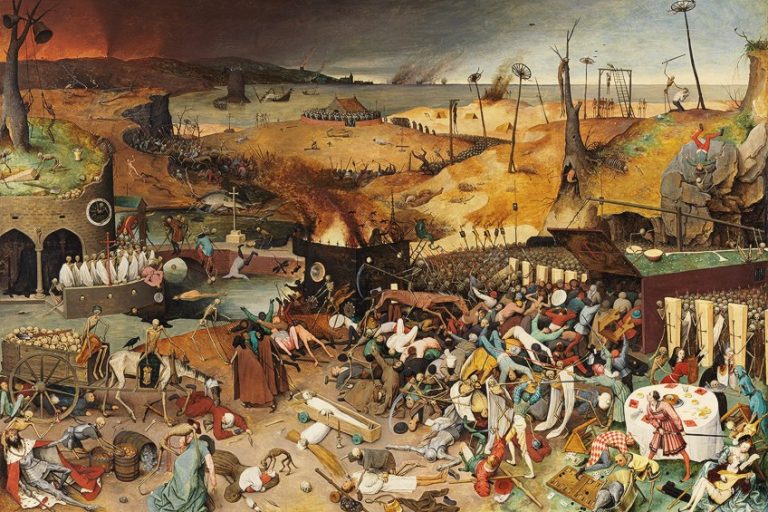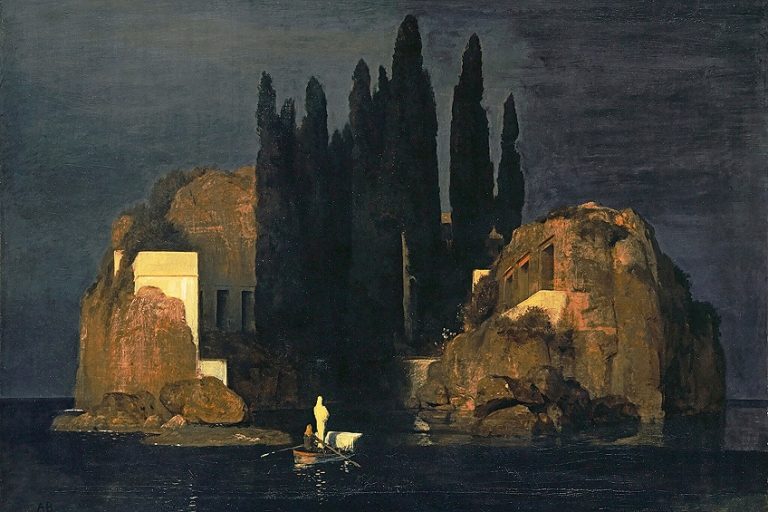Ivan Aivazovsky Paintings – The 13 Most Famous Artworks
Ivan Aivazovsky stands as one of the most eminent and celebrated Russian painters of the 19th century, renowned for his captivating marine landscapes and seascapes. Born in Crimea, Aivazovsky’s profound connection to the Black Sea profoundly influenced his artistic vision, inspiring a lifelong dedication to portraying the dynamic interplay of light, water, and atmosphere. His mastery of capturing the awe-inspiring beauty and power of the sea has left an indelible mark on the art world, earning him international acclaim and recognition as one of the greatest maritime painters of all time. In this article, we will explore 15 of Ivan Aivazovsky’s most notable artworks, each a testament to his unparalleled skill and enduring legacy.
Key Takeaways
- Ivan Aivazovsky was a prominent Russian Romantic painter known for his extensive body of over 6,000 marine paintings.
- His Armenian heritage and Crimean upbringing greatly influenced his recurring themes of seascapes and coastal life.
- Aivazovsky’s work spans a wide variety of subjects including calm seascapes, naval warfare, and the natural beauty of the Russian Empire.
Top 13 Paintings by Ivan Aivazovsky
Ivan Aivazovsky was a prolific Russian Romantic painter known for his breathtaking marine landscapes and seascapes. While he created numerous stunning works throughout his career, listing the most notable paintings by Aivazovsky can be subjective. However, we have put together a selection of 13 famous paintings by Aivazovsky for you to learn about below!

The Bay of Naples (1841)
| Date | 1841 |
| Medium | Oil on canvas |
| Dimensions (cm) | 73 x 97 |
| Where Is It Housed? | The State Russian Museum, St. Petersburg, Russia |
Aivazovsky captures the serene beauty of the Bay of Naples under a golden sunset. The calm waters reflect the warm hues of the sky, creating a tranquil atmosphere.
The painting’s composition draws the viewer’s gaze towards the distant mountains, evoking a sense of awe and wonder.

Chesme Battle (1848)
| Date | 1848 |
| Medium | Oil on canvas |
| Dimensions (cm) | 221 x 332 |
| Where Is It Housed? | The State Russian Museum, St. Petersburg, Russia |
This monumental canvas depicts the dramatic naval Battle of Chesme during the Russo-Turkish War. Aivazovsky’s skillful use of light and shadow highlights the intensity of the conflict, with billowing smoke and fiery explosions engulfing the scene.
The painting’s scale and detail immerse the viewer in the chaos and valor of naval warfare.
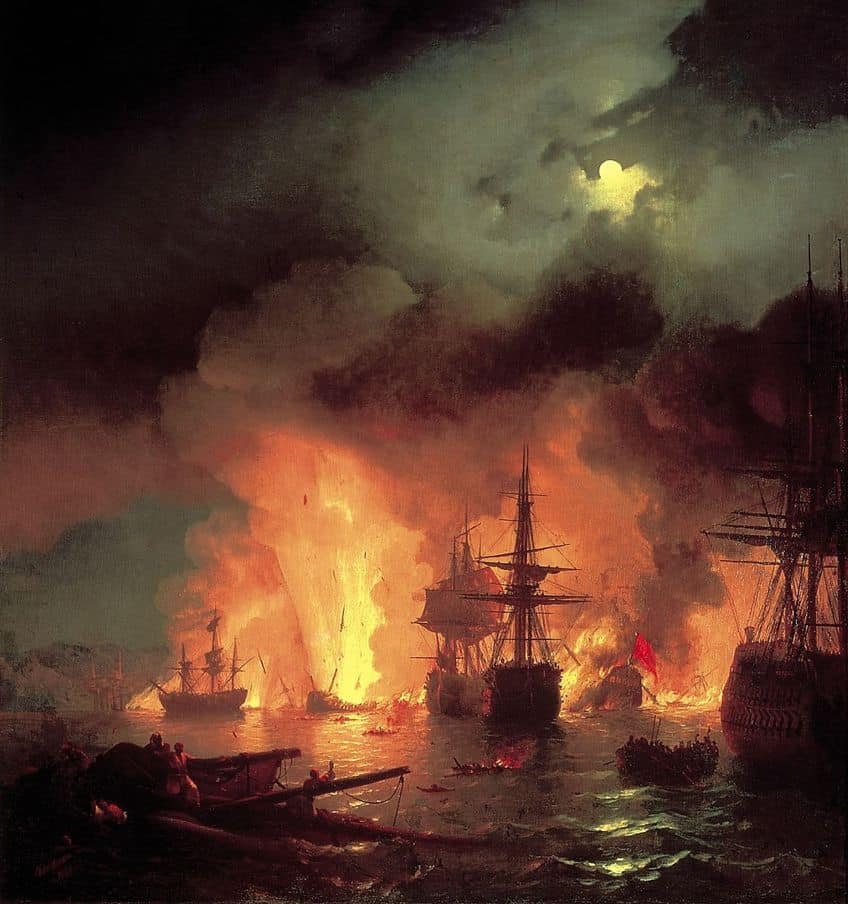
The Ninth Wave (1850)
| Date | 1850 |
| Medium | Oil on canvas |
| Dimensions (cm) | Dimensions not available |
| Where Is It Housed? | The State Russian Museum, St. Petersburg, Russia |
The Ninth Wave is a masterpiece that captures the raw power and unpredictability of the sea. Aivazovsky portrays a massive wave towering over a shipwrecked vessel, conveying the overwhelming force of nature.
The interplay of light and shadow adds depth and drama to the tumultuous seascape, leaving a lasting impression on the viewer.
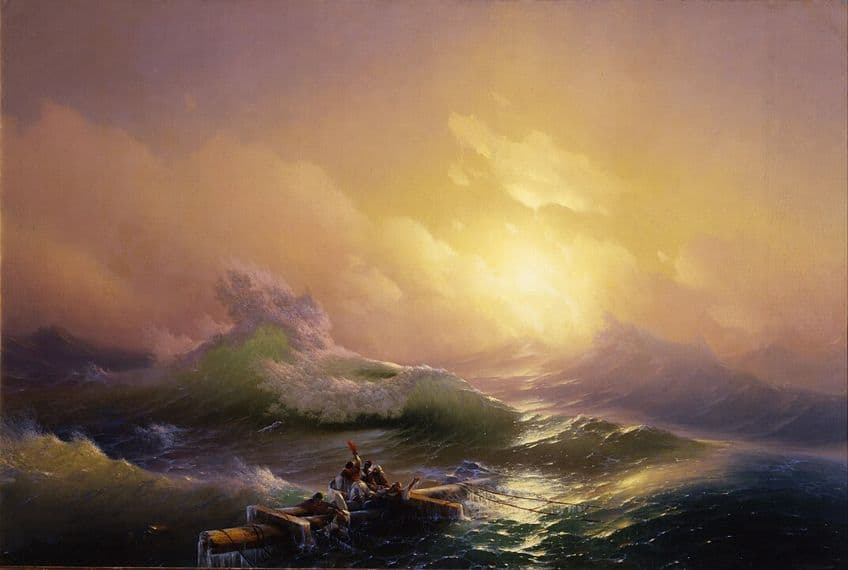
The Battle of Sinop (1853)
| Date | 1853 |
| Medium | Oil on canvas |
| Dimensions (cm) | 250 x 421 |
| Where Is It Housed? | The State Russian Museum, St. Petersburg, Russia |
Aivazovsky commemorates the historic Battle of Sinop with this monumental canvas, depicting the Russian fleet launching a surprise attack on the Ottoman forces. The painting brims with action and drama as ships clash amidst billowing smoke and cannon fire.
Aivazovsky’s meticulous attention to detail and dynamic composition bring the chaotic intensity of naval warfare to life.

The Rainbow (1873)
| Date | 1873 |
| Medium | Oil on canvas |
| Dimensions (cm) | 100 x 151 |
| Where Is It Housed? | The State Russian Museum, St. Petersburg, Russia |
In this mesmerizing seascape, Aivazovsky captures the fleeting beauty of a rainbow arcing over the ocean. The vibrant spectrum of colors contrasts with the deep blue hues of the sea and sky, creating a captivating visual spectacle.
The painting’s tranquil atmosphere and ethereal light evoke a sense of wonder and serenity, inviting the viewer to bask in the beauty of nature’s fleeting moments.

The Black Sea at Night (1879)
| Date | 1879 |
| Medium | Oil on canvas |
| Dimensions (cm) | Dimensions not available |
| Where Is It Housed? | The State Russian Museum, St. Petersburg, Russia |
In this nocturnal scene, Aivazovsky skillfully depicts the Black Sea under the mystical glow of the moon. The tranquil waters shimmer with silver reflections, while distant ships navigate through the darkness.
The painting exudes a sense of mystery and tranquility, inviting the viewer to contemplate the beauty of the nighttime seascape.
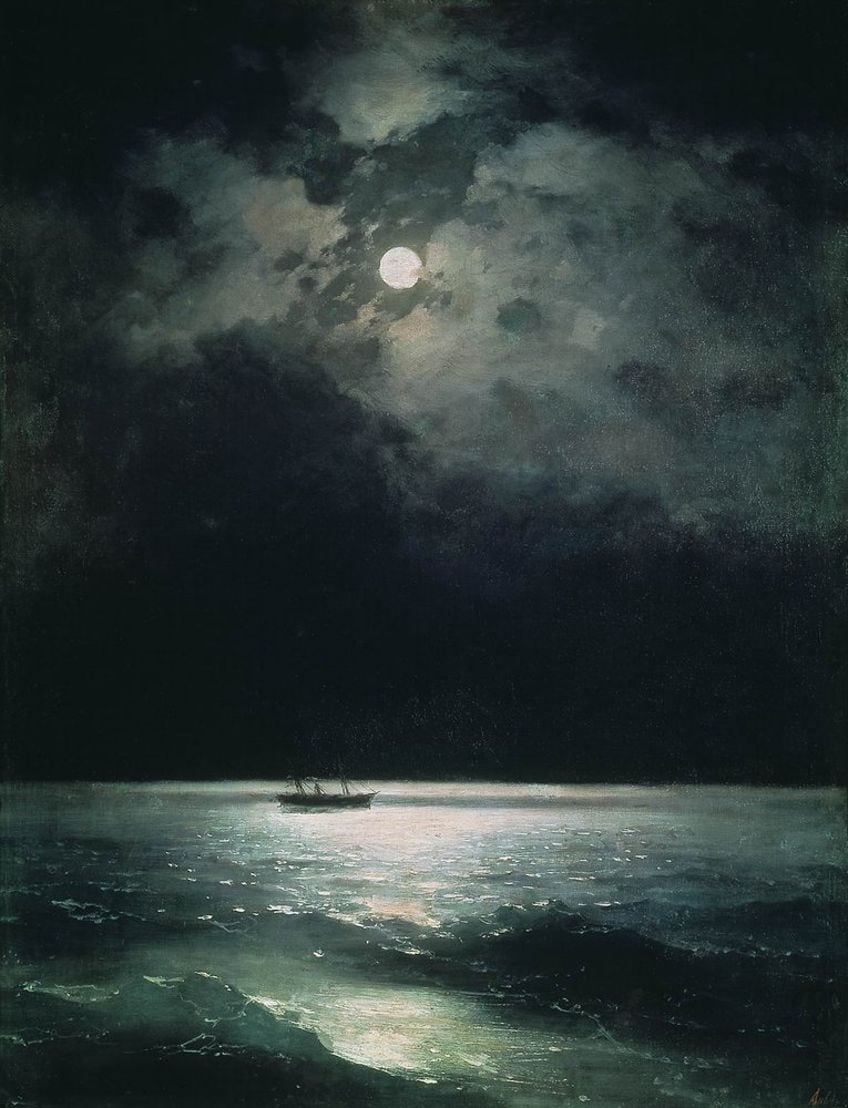
The Black Sea (1881)
| Date | 1881 |
| Medium | Oil on canvas |
| Dimensions (cm) | Dimensions not available |
| Where Is It Housed? | The State Russian Museum, St. Petersburg, Russia |
Aivazovsky’s portrayal of the Black Sea captivates with its vibrant colors and dynamic brushwork. Sunlight dances across the water’s surface, illuminating the waves and creating a sense of movement and energy.
The painting celebrates the sea’s endless expanse and timeless beauty, inviting the viewer to embark on a visual journey across its azure depths.

Shipwreck after a Stormy Sea (1886)
| Date | 1886 |
| Medium | Oil on canvas |
| Dimensions (cm) | 221 x 332 |
| Where Is It Housed? | The State Russian Museum, St. Petersburg, Russia |
Aivazovsky’s late masterpiece captures the aftermath of a violent storm, with a battered shipwreck resting on a desolate shoreline. The tumultuous seas have subsided, leaving behind a scene of desolation and destruction. Aivazovsky’s evocative brushwork and somber palette convey the fragility of human endeavors in the face of nature’s awesome power, inviting contemplation on the transience of life and the enduring force of the sea.

Shipwreck Off the Black Sea Coast (1887)
| Date | 1887 |
| Medium | Oil on canvas |
| Dimensions (cm) | 100 x 150 |
| Where Is It Housed? | The State Russian Museum, St. Petersburg, Russia |
In this poignant scene, Aivazovsky captures the aftermath of a devastating shipwreck amidst stormy seas. The wreckage lies strewn across the shore, a testament to the sea’s unforgiving nature. Aivazovsky’s somber palette and emotive brushwork evoke a sense of tragedy and loss.
By doing so, he is inviting reflection on humanity’s precarious relationship with the forces of nature.
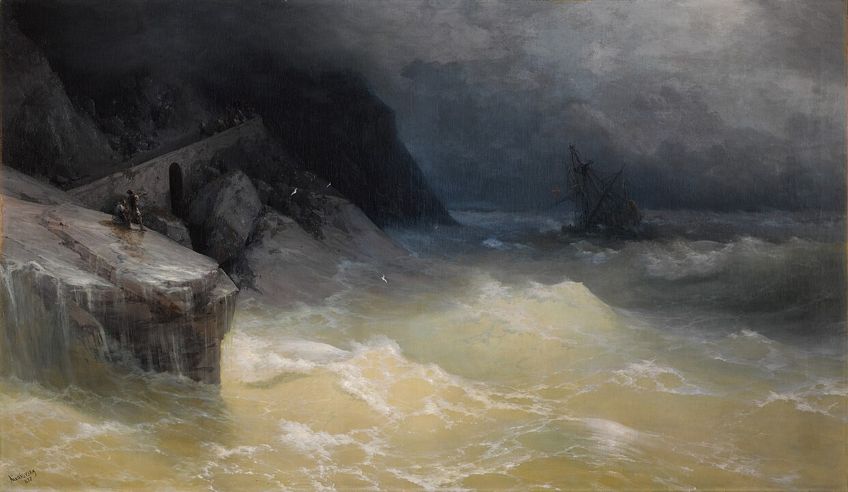
The Black Sea Fleet in Feodosia (1890)
| Date | 1890 |
| Medium | Oil on canvas |
| Dimensions (cm) | 92 x 138 |
| Where Is It Housed? | The State Russian Museum, St. Petersburg, Russia |
This painting portrays the majestic presence of the Russian Black Sea Fleet anchored in the harbor of Feodosia. Aivazovsky captures the grandeur of the naval vessels against the backdrop of a tranquil seascape.
The play of light and shadow infuses the scene with a sense of serenity and reverence, highlighting the fleet’s importance in protecting Russia’s maritime interests.

Brig Mercury Attacked by Two Turkish Ships (1892)
| Date | 1892 |
| Medium | Oil on canvas |
| Dimensions (cm) | 100 x 150 |
| Where Is It Housed? | The State Russian Museum, St. Petersburg, Russia |
Aivazovsky’s late masterpiece depicts the dramatic moment of a naval battle between a Russian brig and two Turkish ships. The painting pulsates with energy as cannons roar and waves crash against the vessels.
Aivazovsky’s meticulous attention to detail and dynamic composition make this artwork a powerful testament to the glory and peril of naval warfare.

Breaking Wave (1895)
| Date | 1895 |
| Medium | Oil on canvas |
| Dimensions (cm) | 221 x 332 |
| Where Is It Housed? | The State Russian Museum, St. Petersburg, Russia |
Aivazovsky’s Wave mesmerizes with its dynamic portrayal of a colossal wave crashing against the shore. The tumultuous waters surge with primal energy, engulfing everything in their path.
The painting’s dramatic composition and vivid palette convey the raw power and relentless motion of the sea, leaving a lasting impression on the viewer.

Among the Waves (1898)
| Date | 1898 |
| Medium | Oil on canvas |
| Dimensions (cm) | 100 x 150 |
| Where Is It Housed? | The State Russian Museum, St. Petersburg, Russia |
Aivazovsky plunges the viewer into the heart of a raging storm with this atmospheric seascape. Waves crash against a rocky coastline, their frothy crests illuminated by flashes of lightning.
The painting’s tumultuous energy and dramatic lighting convey the raw power and untamed beauty of the sea in its most primal state.

Ivan Aivazovsky’s unmatched talent in capturing the sea’s essence makes him an enduring figure in maritime art. His paintings, ranging from serene seascapes to tempestuous storms, continue to captivate audiences with their timeless beauty. Aivazovsky’s legacy serves as a testament to the profound impact of art in revealing the wonders of nature and stirring the human spirit.
Frequently Asked Questions
What Techniques Did Ivan Aivazovsky Employ in His Painting Process?
Ivan Aivazovsky mastered the ability to capture the play of light on water, utilizing a technique that involved layers of transparent paint to depict the sea’s translucency. He is known for the vibrant realism in his seascapes, with an emphasis on the accurate rendering of waves and sky.
How Are Ivan Aivazovsky’s Paintings Valued in the Art Market?
Aivazovsky’s paintings are highly regarded in the art market and can fetch considerable prices at auction. They are especially prized for their historical value and the artist’s reputation as a master of marine art. The demand for Aivazovsky’s original works reflects his standing as one of the foremost Romantic painters, particularly in the genre of maritime painting.
Isabella studied at the University of Cape Town in South Africa and graduated with a Bachelor of Arts majoring in English Literature & Language and Psychology. Throughout her undergraduate years, she took Art History as an additional subject and absolutely loved it. Building on from her art history knowledge that began in high school, art has always been a particular area of fascination for her. From learning about artworks previously unknown to her, or sharpening her existing understanding of specific works, the ability to continue learning within this interesting sphere excites her greatly.
Her focal points of interest in art history encompass profiling specific artists and art movements, as it is these areas where she is able to really dig deep into the rich narrative of the art world. Additionally, she particularly enjoys exploring the different artistic styles of the 20th century, as well as the important impact that female artists have had on the development of art history.
Learn more about Isabella Meyer and the Art in Context Team.
Cite this Article
Isabella, Meyer, “Ivan Aivazovsky Paintings – The 13 Most Famous Artworks.” Art in Context. February 7, 2024. URL: https://artincontext.org/ivan-aivazovsky-paintings/
Meyer, I. (2024, 7 February). Ivan Aivazovsky Paintings – The 13 Most Famous Artworks. Art in Context. https://artincontext.org/ivan-aivazovsky-paintings/
Meyer, Isabella. “Ivan Aivazovsky Paintings – The 13 Most Famous Artworks.” Art in Context, February 7, 2024. https://artincontext.org/ivan-aivazovsky-paintings/.




